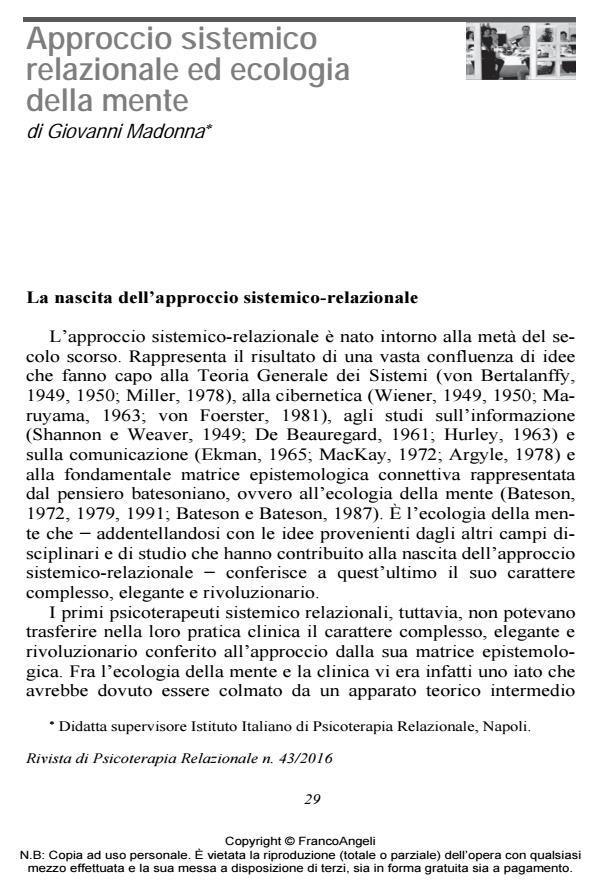Systemic-relational approach and ecology of mind
Journal title RIVISTA DI PSICOTERAPIA RELAZIONALE
Author/s Giovanni Madonna
Publishing Year 2016 Issue 2016/43
Language Italian Pages 11 P. 29-39 File size 160 KB
DOI 10.3280/PR2016-043003
DOI is like a bar code for intellectual property: to have more infomation
click here
Below, you can see the article first page
If you want to buy this article in PDF format, you can do it, following the instructions to buy download credits

FrancoAngeli is member of Publishers International Linking Association, Inc (PILA), a not-for-profit association which run the CrossRef service enabling links to and from online scholarly content.
The author identifies, in the lack of an intermediate theoretical apparatus between the epistemological matrix and clinic, the reason why the former systemic-relational psychotherapists could not transfer in their professional practice the complex, elegant and revolutionary character given to the approach by its epistemological matrix: Gregory Bateson’s ecology of the mind. He recalls Gregory Bateson’s theory of mind - which is an integral and inseparable part of that epistemological matrix - in particular he recalls some of the cornerstones of the theory and he points out the clinical implications of referring to it. He finally considers how the emergence of the paradigm of complexity in science and the advent of second order cybernetics facilitate the reference to Gregory Bateson’s theory of mind and how this can in turn facilitate the connection between epistemology and clinic.
Keywords: Epistemology, theory of mind, clinic, Bateson
- Argyle M. (1978). Il corpo e il suo linguaggio. Bologna: Zanichelli.
- Bateson G. (1972). Verso un’ecologia della mente. Milano: Adelphi.
- Bateson G. (1979). Mente e natura. Milano: Adelphi.
- Bateson G. (1991). Una sacra unità. Altri passi verso un’ecologia della mente, a cura di Donaldson R.E. (1997). Milano: Adelphi.
- Bateson G., Bateson M.C. (1987). Dove gli angeli esitano. Milano: Adelphi.
- De Beauregard O.C. (1961). Sur l’equivalence entre information et entropie. Sciences, 11, pp. 51-58.
- Ekman P. (1965). Communication through non-verbal behaviour: a source of information about interpersonal relationship. In Thompkins S.S. e Izard C.E., eds., Affect, cognition and personality. New York: Springer.
- Hurley W.V. (1963). A mathematical theory of the value of information (relazione 63-3), Port of New Authority, Engineering Department, Reserch and Development Division, New York.
- Korzybski A. (1941). Science and Sanity. New York: Science P.
- Madonna G. (2003). La psicoterapia attraverso Bateson. Milano: Franco Angeli.
- Madonna G. (2010). La psicologia ecologica. Milano: Franco Angeli.
- Madonna G., Nasti F. (2015). Della separazione e della riconnessione. Milano: Franco Angeli.
- Maruyama M. (1963). The second cybernetics: deviation-amplifying mutual casual processes. American Scientist, 51, 164-79.
- Miller J.G. (1978). Sistemi viventi: concetti fondamentali. In Gray W., Duhl F.J., Rizzo N.D., a cura di. Teoria generale dei sistemi e psichiatria. Milano: Feltrinelli.
- Shannon C.E., Weaver W. (1949). The mathematical theory of communication. Urbana: University of Illinois Press.
- von Bertalanffy L. (1949). Das biologische Weltbild. Bern: Francke.
- von Bertalanffy L. (1950). An outline of general systems theory. British Journal of the Philosophy of Science. 1, pp. 134-65.
- von Foerster H. (1981). Sistemi che osservano. Roma: Astrolabio.
- Wiener N. (1949). La cibernetica. Milano: Il Saggiatore.
- Wiener N. (1950). Introduzione alla cibernetica. Torino: Bollati Boringhieri.
Giovanni Madonna, Approccio sistemico relazionale ed ecologia della mente in "RIVISTA DI PSICOTERAPIA RELAZIONALE " 43/2016, pp 29-39, DOI: 10.3280/PR2016-043003